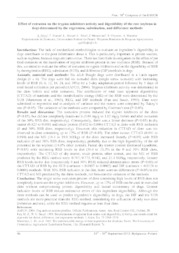Effect of extrusion on the trypsin inhibitors activity and digestibility of the raw soybean in dogs determined by the regression, substitution, and difference methods.
Effect of extrusion on the trypsin inhibitors activity and digestibility of the raw soybean in dogs determined by the regression, substitution, and difference methods.
Author(s): FÉLIX, A.; RAMOS, T.; ALARÇA, L.; BRITO, C.; MANDARINO, J.; OLIVEIRA, S.; MAIORKA, A.
Summary: The lack of standardized methodologies to evaluate an ingredient?s digestibility in dogs contributes to the poor information about it. This is particularly important in protein sources, such as soybean, because dogs are carnivorous. There has been little investigation on the effect of pet food extrusion on the inactivation of trypsin inhibitors present in raw soybeans (RSB). Because of this, we aimed to evaluate the effect of extrusion on trypsin inhibitors and on the digestibility of RSB by the regression (REG), substitution (SUB), and difference (DIF) methods in dogs. Animals, material and methods: Six adult Beagle dogs were distributed in a Latin square design (6 x 6). The dogs were fed six extruded diets (single screw extruder) with increasing levels of RSB (0, 6, 12, 18, 24, and 30%) for a 5-day adaptation period followed by 5 days of total faecal collection per period (AAFCO, 2004). Trypsin inhibitors activity was determined in the diets before and after extrusion. The coefficients of total tract apparent digestibility (CTTAD) of nutrients and the metabolizable energy (ME) of the RSB were determined by the SUB (Matterson et al., 1965), REG, and DIF methods (Fan and Sauer, 1995). Data were submitted to regression and to analysis of variance and the means were compared by Tukey's test (P<0.05). The variances of the methods were compared by Cochran's test (P<0.05). Results and discussion: The extrusion process reduced the trypsin inhibitors of the diets (P<0.05), but did not completely inactivate it (3.09 mg/g to 1.82 mg/g before and after extrusion of the 30% RSB diet, respectively). Consequently, there was a linear decrease (P<0.05) in dry matter (0.823 to 0.808) and crude protein (0.832 to 0.806) CTTAD in diets with RSB inclusion (0 and 30% RSB diets, respectively). However, this reduction in CTTAD of diets was not observed in diets containing up to 12% of RSB (P>0.05). The ether extract CTTAD (0.891 to 0.910) and the ME (18.4 to 19.0 MJ/kg) of the diets increased linearly (P<0.05) with RSB inclusion (0 and 30% RSB diets, respectively), probably due to the high digestibility of the oil presented in the soybean (18.8% ether extract). Faecal dry matter content decreased (quadratic, P<0.05) with increasing RSB levels in diet (36.4 to 31.3% in the 0 and 30% RSB diets, respectively). The CTTAD of dry matter, crude protein, ether extract, and the ME of RSB predicted by the REG method were: 0.767, 0.773, 0.942, and 21.1 MJ/kg, respectively. Greater RSB levels in the diet (respectively 0 and 30% RSB) reduced determination errors (P<0.05) of the CTTAD of RSB by the SUB (variance = 0.0407 to 0.0002) and DIF (variance = 0.0124 to 0.0001) methods. With 30% RSB inclusion in the diet, there were no differences (P>0.05) in the CTTAD and ME predicted by the three methods, nor between the variances of the methods. Conclusion: The single screw extrusion process of diets containing high levels of RSB does not completely inactivate the trypsin inhibitors. However, up to 12% of RSB can be used in extruded diets without compromising protein digestibility and faecal consistency of dogs. Greater inclusion levels of RSB reduce estimative errors of this ingredient digestibility. Although the three methods can be used to predict ingredients digestibility in dogs, the DIF and the SUB methods are more practical than the REG method, considering the utilization of only two diets (reference and test), while the REG method requires at least four diets.
Publication year: 2012
Types of publication: Paper in annals and proceedings
Unit: Embrapa Soybean
Keywords: Animal nutrition, Nutrição animal, Soja, Soybeans
Observation
Some of Embrapa's publications are published as ePub files. To read them, use or download one of the following free software options to your computer or mobile device. Android: Google Play Books; IOS: iBooks; Windows and Linux: Calibre.
Access other publications
Access the Agricultural Research Database (BDPA) to consult Embrapa's full library collection and records.
Visit Embrapa Bookstore to purchase books and other publications sold by Embrapa.

